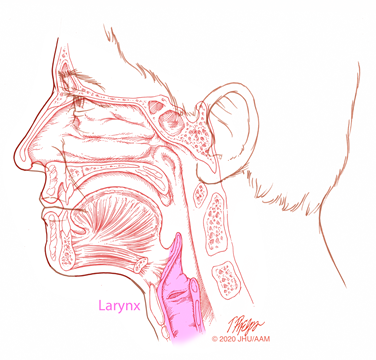Laryngeal Cancer
Featured Expert:
The larynx, commonly called the voice box, is a cartilage encased organ with three critical functions:
- The production of sound
- Maintaining an open breathing passage
- Closing the airway during swallowing to prevent aspiration.
Treatment of disorders of the larynx including cancer must take these functions into account.

Larynx Anatomy
The larynx is divided into three anatomical regions or levels:
- Supraglottis: Tissues above the sound producing structures
- Glottis: The sound producing vocal cords
- Subglottis: The area below the vocal cords but above the windpipe or trachea.
Symptoms and treatment of laryngeal cancer depends to some degree on the region(s) involved.
What is Laryngeal Cancer?
Most cancers that arises in the larynx begin on the mucosal surface and are called squamous cell carcinoma (SCC). Much less common forms of laryngeal cancers are salivary gland cancers which arise from the tiny salivary glands below the mucosa, or cancers arising from muscle, cartilage or other structural tissues (sarcomas). SCC of the larynx is associated with smoking, although the contribution of secondhand smoke and the effect of past smoking are less certain. Some cases of laryngeal cancer arise without known risk factors.
What are symptoms of laryngeal cancer?
Early laryngeal cancer may not have any symptoms at all. Small growths of the vocal cords may produce hoarseness or coughing, making glottic cancer more likely to be diagnosed early. Early cancer of the supraglottis (above the vocal cords) may cause pain, perhaps made worse with swallowing, and the pain may feel like it involves the ear, a phenomenon known as referred ear pain.
Moderate to advanced laryngeal cancer may cause:
- Difficulty or painful swallowing
- Difficulty breathing
- Noisy breathing
- Severe hoarseness
- Coughing of blood (hemoptysis)
- Mass or growth in the neck
Johns Hopkins Head and Neck Cancer Specialists

Our head and neck surgeons and speech-language pathologists take a proactive approach to cancer treatment. Meet the Johns Hopkins specialists who will work closely with you during your journey.
How is laryngeal cancer diagnosed?
The larynx cannot be seen by health care providers without special equipment. The larynx can be seen using a laryngeal mirror, or a fiberoptic telescope with a video camera. Cancer typically causes changes in the appearance of the mucosal lining or the symmetrical structures of the larynx that can be seen with these devices. It also may be detected using radiographic imaging including MRI, CT scan or ultrasound.
When a suspicious larynx lesion is detected additional testing to confirm the diagnosis is performed by obtaining a biopsy, taking a small sample of the tissue. Because of the sensitivity of the larynx this must be done under general anesthesia in an operating room in most cases. At the same time, the surgeon can gather important information about the extent of the tumor by more thorough visualization and directly touching the tissues. A PET/CT scan or other imaging study may be done to assess the status of lymph nodes and possible spread.
How is laryngeal cancer treated?
Laryngeal cancer treatment is determined by the:
- Type of cancer
- Extent or stage of the tumor
- Precise portions of the larynx involved with tumor.
There are three types of treatment available for most cancers including laryngeal cancer:
- Surgery
- Radiation therapy
- Chemotherapy
Early Laryngeal Cancer
Early cancers (smaller tumors with minimal involvement of the larynx) may be treated successfully with just one of these types of treatment; more advanced cancers may require combined therapy using two or all three types of treatment.
Selected early cancers of the vocal cords (glottis) and supraglottis (above the vocal cords) may be removed through the mouth using minimally invasive surgery such as a robot or with a laser. If you are not a candidate for surgery, alternative treatment is full course radiation therapy.
Advanced Laryngeal Cancer
Mid-sized cancers are often treated with a combination of chemotherapy and radiation therapy. Very extensive cancers that have already grown beyond the cartilage walls of the voice box or have caused destruction of laryngeal function are treated with surgery followed by radiation therapy.
Types of Surgery to Remove Laryngeal Cancers
Head and neck surgeons use a range of surgical procedures to treat selected laryngeal cancer including approaches that preserve the three functions of the larynx. For the most extensive cases, surgery must remove the entire larynx (total laryngectomy), a procedure that separates the breathing and swallowing passages allowing safe secure breathing and resumption of a normal diet, but with a permanent breathing opening in the neck. Patients who undergo total laryngectomy can resume speech using one of several approaches such as voice prosthesis or electrolarynx.
Johns Hopkins Head and Neck Cancer Surgery

Our team offers comprehensive treatments for cancers affecting the nasal passages, sinuses, the throat and nearby areas. Our head and neck surgeons work closely with medical and radiation oncologists, endocrinologists and other specialists to provide well-rounded care.







